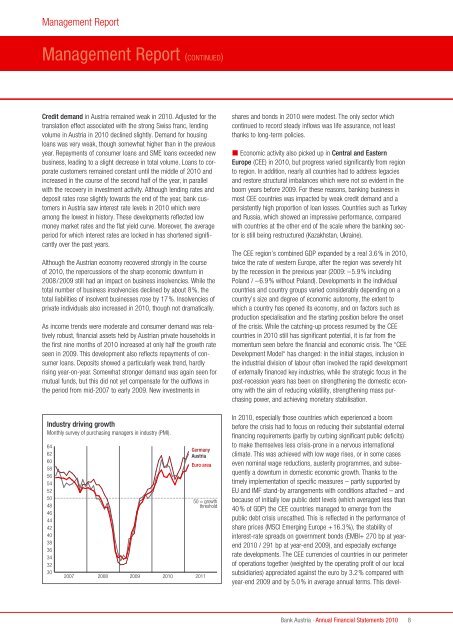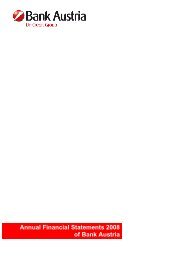Annual Financial Statements 2010 of Bank Austria
Annual Financial Statements 2010 of Bank Austria
Annual Financial Statements 2010 of Bank Austria
Create successful ePaper yourself
Turn your PDF publications into a flip-book with our unique Google optimized e-Paper software.
Management Report<br />
Management Report (CONTINUED)<br />
Credit demand in <strong>Austria</strong> remained weak in <strong>2010</strong>. Adjusted for the<br />
translation effect associated with the strong Swiss franc, lending<br />
volume in <strong>Austria</strong> in <strong>2010</strong> declined slightly. Demand for housing<br />
loans was very weak, though somewhat higher than in the previous<br />
year. Repayments <strong>of</strong> consumer loans and SME loans exceeded new<br />
business, leading to a slight decrease in total volume. Loans to corporate<br />
customers remained constant until the middle <strong>of</strong> <strong>2010</strong> and<br />
increased in the course <strong>of</strong> the second half <strong>of</strong> the year, in parallel<br />
with the recovery in investment activity. Although lending rates and<br />
deposit rates rose slightly towards the end <strong>of</strong> the year, bank customers<br />
in <strong>Austria</strong> saw interest rate levels in <strong>2010</strong> which were<br />
among the lowest in history. These developments reflected low<br />
money market rates and the flat yield curve. Moreover, the average<br />
period for which interest rates are locked in has shortened significantly<br />
over the past years.<br />
Although the <strong>Austria</strong>n economy recovered strongly in the course<br />
<strong>of</strong> <strong>2010</strong>, the repercussions <strong>of</strong> the sharp economic downturn in<br />
2008/2009 still had an impact on business insolvencies. While the<br />
total number <strong>of</strong> business insolvencies declined by about 8%, the<br />
total liabilities <strong>of</strong> insolvent businesses rose by 17%. Insolvencies <strong>of</strong><br />
private individuals also increased in <strong>2010</strong>, though not dramatically.<br />
As income trends were moderate and consumer demand was relatively<br />
robust, financial assets held by <strong>Austria</strong>n private households in<br />
the first nine months <strong>of</strong> <strong>2010</strong> increased at only half the growth rate<br />
seen in 2009. This development also reflects repayments <strong>of</strong> consumer<br />
loans. Deposits showed a particularly weak trend, hardly<br />
rising year-on-year. Somewhat stronger demand was again seen for<br />
mutual funds, but this did not yet compensate for the outflows in<br />
the period from mid-2007 to early 2009. New investments in<br />
Industry driving growth<br />
Monthly survey <strong>of</strong> purchasing managers in industry (PMI).<br />
64<br />
62<br />
60<br />
58<br />
56<br />
54<br />
52<br />
50<br />
48<br />
46<br />
44<br />
42<br />
40<br />
38<br />
36<br />
34<br />
32<br />
30<br />
Germany<br />
<strong>Austria</strong><br />
Euro area<br />
50 = growth<br />
threshold<br />
2007 2008<br />
2009 <strong>2010</strong> 2011<br />
shares and bonds in <strong>2010</strong> were modest. The only sector which<br />
continued to record steady inflows was life assurance, not least<br />
thanks to long-term policies.<br />
� Economic activity also picked up in Central and Eastern<br />
Europe (CEE) in <strong>2010</strong>, but progress varied significantly from region<br />
to region. In addition, nearly all countries had to address legacies<br />
and restore structural imbalances which were not so evident in the<br />
boom years before 2009. For these reasons, banking business in<br />
most CEE countries was impacted by weak credit demand and a<br />
persistently high proportion <strong>of</strong> loan losses. Countries such as Turkey<br />
and Russia, which showed an impressive performance, compared<br />
with countries at the other end <strong>of</strong> the scale where the banking sector<br />
is still being restructured (Kazakhstan, Ukraine).<br />
The CEE region’s combined GDP expanded by a real 3.6% in <strong>2010</strong>,<br />
twice the rate <strong>of</strong> western Europe, after the region was severely hit<br />
by the recession in the previous year (2009: –5.9% including<br />
Poland / –6.9% without Poland). Developments in the individual<br />
countries and country groups varied considerably depending on a<br />
country’s size and degree <strong>of</strong> economic autonomy, the extent to<br />
which a country has opened its economy, and on factors such as<br />
production specialisation and the starting position before the onset<br />
<strong>of</strong> the crisis. While the catching-up process resumed by the CEE<br />
countries in <strong>2010</strong> still has significant potential, it is far from the<br />
momentum seen before the financial and economic crisis. The “CEE<br />
Development Model“ has changed: in the initial stages, inclusion in<br />
the industrial division <strong>of</strong> labour <strong>of</strong>ten involved the rapid development<br />
<strong>of</strong> externally financed key industries, while the strategic focus in the<br />
post-recession years has been on strengthening the domestic economy<br />
with the aim <strong>of</strong> reducing volatility, strengthening mass purchasing<br />
power, and achieving monetary stabilisation.<br />
In <strong>2010</strong>, especially those countries which experienced a boom<br />
before the crisis had to focus on reducing their substantial external<br />
financing requirements (partly by curbing significant public deficits)<br />
to make themselves less crisis-prone in a nervous international<br />
climate. This was achieved with low wage rises, or in some cases<br />
even nominal wage reductions, austerity programmes, and subsequently<br />
a downturn in domestic economic growth. Thanks to the<br />
timely implementation <strong>of</strong> specific measures – partly supported by<br />
EU and IMF stand-by arrangements with conditions attached – and<br />
because <strong>of</strong> initially low public debt levels (which averaged less than<br />
40% <strong>of</strong> GDP) the CEE countries managed to emerge from the<br />
public debt crisis unscathed. This is reflected in the performance <strong>of</strong><br />
share prices (MSCI Emerging Europe +16.3%), the stability <strong>of</strong><br />
interest-rate spreads on government bonds (EMBI+ 270 bp at yearend<br />
<strong>2010</strong> / 291 bp at year-end 2009), and especially exchange<br />
rate developments. The CEE currencies <strong>of</strong> countries in our perimeter<br />
<strong>of</strong> operations together (weighted by the operating pr<strong>of</strong>it <strong>of</strong> our local<br />
subsidiaries) appreciated against the euro by 3.2% compared with<br />
year-end 2009 and by 5.0% in average annual terms. This devel-<br />
<strong>Bank</strong> <strong>Austria</strong> · <strong>Annual</strong> <strong>Financial</strong> <strong>Statements</strong> <strong>2010</strong><br />
8
















